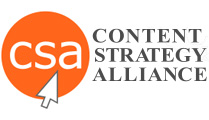Ugh. “We need to talk.” Nothing good ever seems to comes after that… But seriously, there are some things we need to sort out together.
Let’s start with the good news: Content is hot. Positively en fuego:
● 90% of organizations market with content (source)
● 67% of surveyed B2B companies reported marketing content a top three or higher priority within their overall 2015 marketing strategy. (source)
● 78% of CMOs think custom content is the future of marketing. (source)
● 54.1% of marketers are prioritizing hiring for marketing content above all other marketing sub-groups. (source)
• CNNMoney even ranked content strategist among the 100 best jobs in America for 2015. Not a bad environment in which to be a content creator or content strategist, huh?
But with rapid growth come growing pains. And that’s the part that we need to sort out together.
We need to clearly define what content strategy is and who does it
• In 2014 the Content Strategy Alliance (CSA) conducted an international Content Strategy Survey. Out of 1,255 respondents, 72.3 percent identified “defining content strategy, best practices, and skill sets” as a concern they’d like to see addressed.
• The CSA also learned that a solid quarter of professionals engaged in content strategy have only 2-3 years of experience, and a full 80% are self-taught.
• Moreover, of the 90.5 percent of respondents who reported doing content strategy work, fully 61.7 percent did not hold the title “Content Strategist.” Not surprising, really. Graphic artists, copywriters, editors, brand strategists, SEOs, and public relations specialists all engage – even specialize – in content strategy and content marketing.
We need to practice teamwork
With so many professionals playing important roles in content strategy and marketing, it’s easy to end up with a bad case of too many cooks in the kitchen. You probably have a war story of your own about a content project gone horribly wrong. Please, share it with us.
But if there’s one thing I’ve learned it’s this: the problem isn’t how many cooks are in the kitchen – it’s how well we work together.
One project exemplified this for me.
A marketing consultant I know was helping a customer modernize their web presence. The customer engaged a separate web development firm to redesign their site. Six months into the project, the new website was going nowhere fast and the customer was growing frustrated. So, my friend hired me to diagnose and fix the problem.
What I learned was that while the marketing consultant was convinced the web developer was incompetent, she was actually waiting on him to deliver content – content he didn’t even have. It had to come from the customer directly. Simply put: these cooks couldn’t even agree on the recipe.
Ultimately, I was able to get the project back on track and finished in no time simply by facilitating some much-needed communication.
•
And that’s what it’s all about, my friends: communication. Particularly, when one customer hires multiple contractors (or multiple firms) to develop content.
Smoothing out the wrinkles in content projects
I have a 3-step formula for fixing some of the most frustrating problems that arise in content projects.
Step one: talk to each other
Ahead of time.
Let’s engage in networking to get to know each other. Find out what other professionals are struggling with when it comes to content projects, and what kind of support we can lend each other.
Step two: talk to each other
At the beginning of each project.
It sucks to be the last one brought in on a content project. Like the copywriter who has to figure out how to sell a product in just three lines because the design is finished and that’s all there’s room for.
Let’s not do that to one another. If a customer hires you to do design/copywriting/social media/whatever use the network you built in step one to get everyone involved from day one.
Step three: talk to each other
During the project.
Let’s face it, customers don’t always understand what goes into a content project and consequently kinda suck at coordinating their contractors. So it’s up to us to work together as a team.
Having learned this lesson I’ve begun offering project management services, taking the lead to make sure the SEO gets consumer insights from the market researcher, and the copywriter gets keywords from the SEO, and the designer gets copy from the copywriter . . . you get the picture. This kind of coordination results in higher quality content projects that finish faster with fewer headaches all around.
How you can get involved to improve content for everybody
The Content Strategy Alliance (CSA) is working to support content strategists and content marketers everywhere. They’ve begun assembling resources like Content Strategy Tools & Templates: A Best Practices Handbook Tools & Templates Handbook, a mentorship program, and an upcoming certification program to aid and educate the industry.
But the CSA needs help. They’re looking for smart, enthusiastic volunteers like you to shape the future of content strategy. Become a member to get involved and have your voice heard.
About the author:
Alexa Steele is a copywriter and marketing consultant specializing in digital communications. She has been writing premium marketing content since 2009, and is now available to manage your content projects from concept to completion.
Connect with Alexa on LinkedIn.
